Power Your Way to Better Lifts With Thrusters (original) (raw)
The thruster combines the front squat and the overhead press into one explosive movement. Often seen in CrossFit gyms and at the Games, the thruster is deemed one of the more challenging — and sometimes dreaded — exercises you can perform in the gym due to the demand for strength and power.
A full-body exercise that challenges strength and power, the thruster has been popular for years, and for good reason too. As much as you might even tremble at the word, know that the burn you’ll feel from thrusters is worth the benefits they provide.
- How to Do the Thruster
- Benefits of the Thruster
- Muscles Worked By the Thruster
- Who Should Do the Thruster
- Thruster Sets and Reps
- Thruster Variations and Alternatives
- Frequently Asked Questions
How to Do the Thruster
If you know how to squat and overhead press properly, the thruster should be a smooth transition. Below is a step-by-step guide on how to perform the thruster.
Step 1 — Assume a Front Rack Position
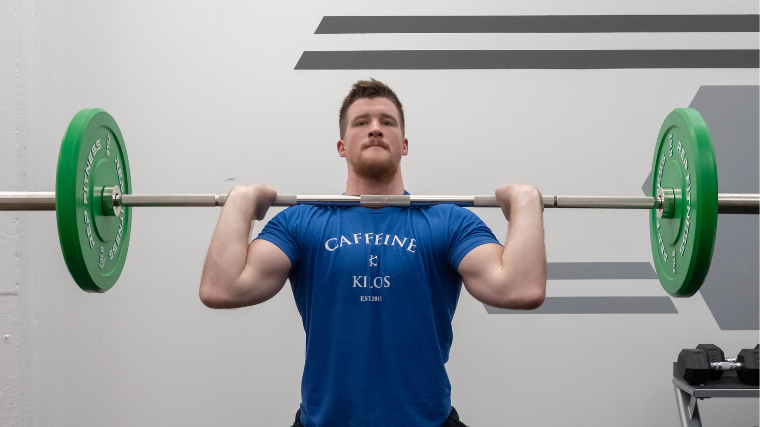
Start with the barbell in the front rack position, placed in your hands with your palms towards the ceiling at shoulder height and elbows high. This is the same position you hold in a front squat or after catching a clean.
Coach’s Tip: You can perform thrusters both from a rack or by cleaning it from the ground.
Step 2 — Squat Down
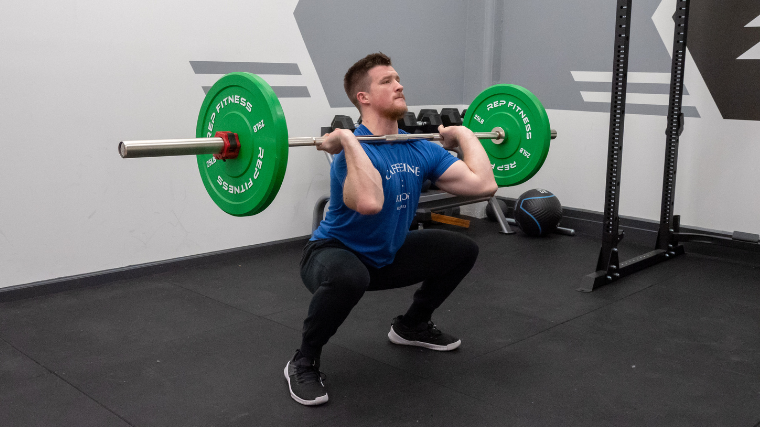
The bar should remain in the front rack position and your chest should stay tall as you squat. Your hips move first as you sit in the squat, with your weight dispersed evenly across your foot. Push your knees out and forward to get low enough.
Coach’s Tip: Be sure to assume an upright squat position because your legs will be utilized for power in the concentric aspect of the lift.
Step 3 — Drive Your Legs
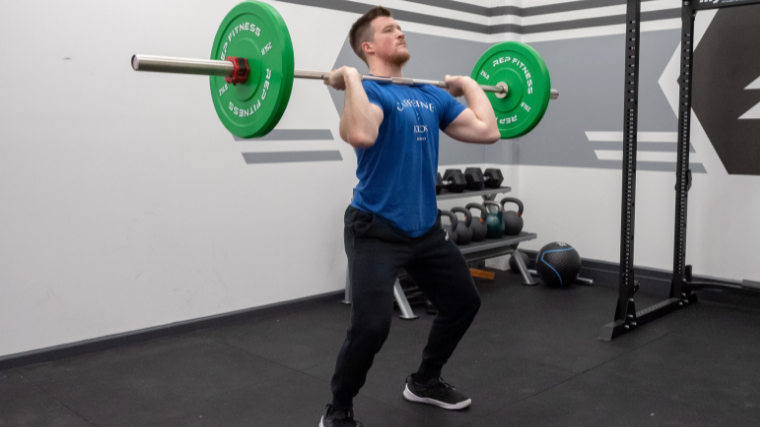
From the squat position, press through the floor and drive straight up, using the power from your legs.
Coach’s Tip: Leg drive is an important part of the thruster because that is initially what drives the weight and is helpful with heavier loads or high volume.
Step 4 — Continue Pushing
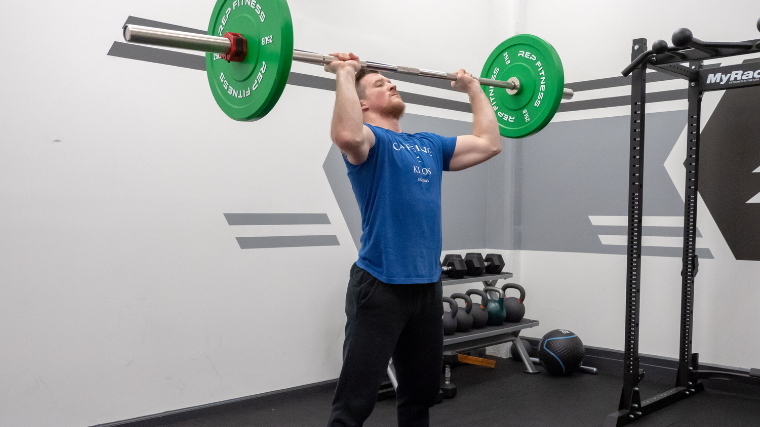
As you come to a standing position, forcefully extend your knees, hips, and glutes to powerfully drive the barbell off your shoulders.
Coach’s Tip: Avoid overextending the hips by thrusting too far forward. This could lead to arching the back, making for a less effective motion and potential injury.
Step 5 — Drive Overhead
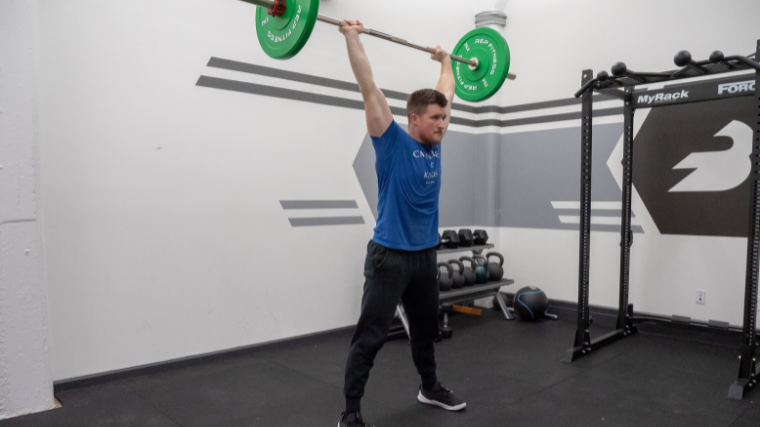
As you thrust the bar overhead, simultaneously lock out your arms. The power exerted from your hips will allow your lower body to take the brunt of the weight instead of your upper body. Once your elbows are locked out, return the bar to the front rack position and get ready for another rep.
Coach’s Tip: The bar should travel in a straight line overhead to help avoid potential injury. Many lifters will try to press too soon, forgetting to fully utilize their legs and power to assist in the movement.
Benefits of the Thruster
The thruster accrues several benefits that can translate to other lifts and your overall health. They have the ability to burn loads of calories, help increase strength, and a whole lot more.
Total Body Strength and Power
The thruster utilizes some of the largest muscles of the body to promote high amounts of force. Unlike other strength lifts, the thruster is also dependent on rate of force development, much like the push press and jerk, making it a great total body exercise.
Metabolic Exercise
Movements that have a full range of motion, are compound, and stress a great amount of muscle tissue are prime exercises to build into metabolic circuits, AMRAPs, and EMOMs. The thruster has a wide array of applications to strength, power, and fitness sports, allowing a coach to change loading and rep ranges to suit the individual demands of the athlete. It is for this reason the thruster is a great functional movement for all athletes, regardless of their goal.
Increased Shoulder and Triceps Strength
The thruster can increase triceps and shoulder strength significantly when programmed with heavier loads. Utilizing the lower body in the movement can be a great way to increase overhead pressing volume, much like the push press.
Both of which allow you to subject your shoulders and triceps muscles to heavier loads than what they presumably would be able to handle in a standard press.
Improved Balance and Coordination
The timing and body awareness required for the thruster can help to improve your balance and coordination. Balance is your ability to move and function properly and improves your ability to perform daily movements such as walking up and down the stairs.
Coordination can be just as important to practice as balance, as studies suggest that good coordination may be linked with cognitive function. (1)
Improved Cardiovascular Health
Just a few reps of the thruster are guaranteed to get your heart rate up, and cardiovascular exercise can be important for athletic performance and overall health. Studies suggest that the leading cause of death in men and women in the United States is heart disease related, but regular cardiovascular exercise can have the ability to reduce this risk. (2) The thruster tests your strength and your cardio and can improve cardiovascular health.
Muscles Worked By the Thruster
The thruster challenges the entire body to move in a coordinated effort to promote force with the legs, core, and upper body. Below are the primary muscle groups involved in this exercise.
Deltoids
Although the thruster is a leg-driven movement, your shoulders assist in the pressing of the load to its final lockout position. Strengthening your shoulders can help prevent injuries in and outside the gym. Research suggests that 36% of injuries occur in the shoulders, and that exercising the shoulders properly and safely may help reduce this. (3) A strong overhead game will also assist in other lifts such as the split jerk.
Quadriceps
Your quadriceps help support your knees and are responsible for walking, jumping, running, and squatting. Strong legs are necessary for thrusters, as the front squat is the base of the movement. Strong quadriceps are needed to increase thruster strength, muscular hypertrophy, and performance. Without well developed legs, the overall abilities of a lifter will be limited with the thruster.
Glutes
Glutes are responsible for stabilizing and extending the hip joint, which is important for lower body exercises, sport activities, and daily life. These muscles are some of the strongest muscles in the body and are activated in the thruster, particularly when you are in the squat position.
Hamstrings
One of the main functions of the hamstrings is helping with hinging at the hips and bending at the knees. You use these muscles when you’re walking or running, so keeping them strong can help improve your daily function. Since the thruster involves the hips and the knees, the hamstrings are targeted during this exercise.
Triceps
The triceps assist the shoulders and legs in the thruster, and are primarily responsible for the lockout of the load overhead. The triceps must work to extend the elbows, which can often be a limiting factor in the heaviest of thrusters. To improve lockout strength, you can do exercises that specifically attack extension positions of the elbow, such as the floor press or other partial ranges of motion presses.
Core
A proper front rack position challenges your core to stay upright, and strong abs help limit the stress on your lower back. Your core can help with safety outside of the gym as well. Exercising your core regularly can help increase general strength and stability, which can help improve your front rack position.
Who Should Do the Thruster
Thrusters aren’t just good for Olympic lifters or CrossFitters — they are too versatile and too effective to be pigeonholed into one category. Below are some groups who can benefit from performing the thruster.
Powerlifters and Strongman Athletes
Aside from using thrusters as a low-impact conditioning tool to increase dynamic movement, caloric expenditure, and a great primer movement before squats, the thruster can also be done to enhance aggression out of the bottom of the squat and overload the lockout position of the overhead press.
Olympic Weightlifters
In weightlifting, the thruster can be a beneficial exercise to train the receiving position and recovery in the clean. The thruster can help an Olympic weightlifter increase strength and speed necessary to rebound from a max-effort clean & jerk attempt.
[Read More: The Best Upper Body Exercises and Workouts]
Additionally, the lifter is forced to fight to be as vertical as possible and finish upwards in the drive phase of the thruster, which is nearly identical to that of the jerk. Lastly, the thruster can be performed from the racks to help lifters who struggle out of the hole in the squat or have trouble staying upright in the front squat.
Functional Fitness Athletes
CrossFit and competitive functional fitness athletes know all too well the sport specific need to be efficient and strong at thrusters, whether you’re using dumbbells, kettlebells or barbells. Nonetheless, thrusters are a necessary and vital movement to develop work capacity, leg endurance, movement coordination, and sport-specific efficiency.
Thruster Sets and Reps
The thruster can be performed with more or less sets and/or reps to focus on either strength, hypertrophy, or endurance. Below are training recommendations but are not the only way to perform this exercise.
For Strength
Lifters can use heavy thrusters as the primary strength movement of a day, with the limiting factor often being the upper body. Additionally, thrusters can be used to offer submaximal volume to the lower body as well, and increase rate of force development out of the front squat.
To get stronger with thrusters, perform four to six sets of two to five repetitions. Rest two to three minutes between sets.
For Muscle Building
Moderate to heavy loaded thrusters are a great way to build overall muscle mass due to their high loading potential. More hypertrophy-based thruster workouts will often challenge the muscles in the upper body, such as the triceps and shoulders, more so than the legs.
To pack on muscle size, perform four to six sets of up to 12 repetitions. Rest one to two minutes in between each set.
For Endurance
Some lifters may want to train for greater muscle endurance for sport activities, in which higher repetition ranges and/or shorter rest periods are recommended. These can be done with light loads to increase muscular stamina and endurance and/or to specifically attack aerobic capacity.
To boost endurance, perform two to three sets of 12 or more repetitions. Rest 60-90 seconds in between sets.
Thruster Variations and Alternatives
Whether you’re a beginner, intermediate, or advanced lifter, the thruster can be a great exercise to add to your workout. The variations below can be substituted for the popular barbell thruster depending upon your goals and/or limitations.
Double Kettlebell Thruster
The double kettlebell thruster is a challenging thruster variation that can develop stronger core muscles, legs, posture. The double kettlebell thruster not only forces a lifter to have greater unilateral control during the thruster, but also is loaded in a manner that reinforces proper upright squat positioning and breathing/breaking during heavy thruster training. It is for this reason that the double kettlebell thruster is presumably one of the more challenging and complex thruster variations.
Double Dumbbell Thruster
Similar to the kettlebell thruster, two dumbbells are used instead of a barbell. Dumbbell and barbell thrusters will still produce similar benefits, however dumbbells have other benefits that can help increase stabilization and improve asymmetries. The dumbbell thruster can be a good variation if your front rack with the barbell needs improvement, but you’re still looking to get a lot of the benefits of a barbell thruster.
Cluster
The cluster, like the clean + push press, is a combination movement that is very similar to the thruster. The cluster is a squat clean directly into a thruster, without pausing in between to reset, unlike the clean + push press. This continuous and fluid clean, squat, and press is highly challenging on total body strength, coordination, and power.
Push Press
The push press is an upper body power and strength movement that is essentially a thruster without the full depth squat. In the push press, the lifter dips into a quarter squat, using some leg strength and power, exploding upwards to finish with the load overhead.
Both movements can be used to build power and athleticism, with the push press also being used when trying to limit lower body involvement, possibly due to fatigue or injury.
Wall Balls
While the wall ball lacks the ability to build muscle mass, strength, and challenge a lifter’s muscular endurance under heavy loads, the movement patterning is very similar to that of a thruster, making it a good swap for lifters looking to use lighter loads. The wall ball can be used if your goal is heart rate training and can minimize muscular fatigue in the upper body.
Final Thoughts
Even if the thruster is difficult and taxing, it’s worth the pain because of the benefits they can produce. Since there are several different variations, you probably won’t get bored with this exercise, either.
No matter which variation you may choose, the thruster can increase your cardio health, strength, and overall performance. If you’re as convinced as we are to add thrusters into your workout, pick up a barbell and get to work.
FAQs
The thruster can be a complex exercise to master, from learning how to stay in a front rack to thrusting the hips with enough power. Below are some questions you may be asking yourself about this exercise.
How do I improve my front rack position?
The front rack should improve on its own if you spend time in the posture. However, if you can’t get your elbows up enough, try stretching your lats and shoulders. After that, tight wrists might be holding you back. Patience is key when it comes to improving mobility.
Why does my upper body get tired before my legs?
It is normal to feel fatigue in your upper body, specifically your shoulders and triceps. Your legs are larger muscles, and can thus perform for longer durations and with heavier loads. Let your legs do the work for the majority of the lift.
References
- Fernandes, Valter R., Scipiao Ribiero, Michelle L., & Melo, Thais. Motor Coordination Correlates with Academic Achievement and Cognitive Function in Children. Frontiers in Psychology. 2016; 7. doi: 10.3389/fpsyg.2016.00318
- Agarwal, Shashi K. Cardiovascular Benefits of Exercise. International Journal of Medicine. 2012;5. doi: 10.2147/IJGM.S30113
- Escalante, Guillermo, Fine, Daniel, & Ashworth, Kyle. Progressive Exercise Strategies to Mitigate Shoulder Injuries Among Weight-Training Participants. Strength and Conditioning Journal. 2021; 43(1). doi: 10.1519/SSC.0000000000000547
Featured Image: Dusan Petkovic / Shutterstock